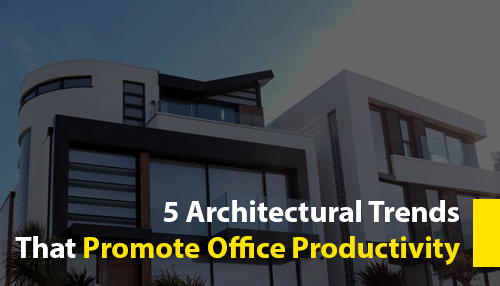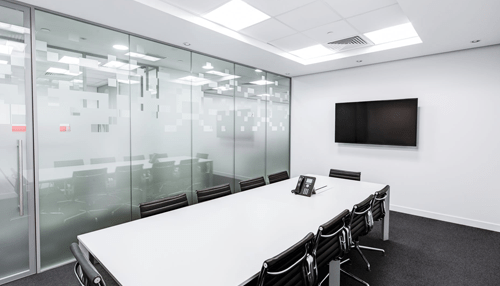Ask CEOs and business owners everywhere what they want from their employees. More often than not, they’re looking for increased productivity from their workforce. Office productivity directly impacts income and morale. The reality is that if your team is struggling to perform, your overall results will plummet, too.
The problem is that there’s no cut-and-dry answer to increase productivity. There are different management suggestions, varying motivational techniques, and a slew of other remedies for fixing productivity slumps. While some might be effective, the truth is that the focus on productivity needs to begin in the design of the office building.
The environment has a lot to do with employees’ ability to thrive. Everything from color to light to space can all impact output. For this reason, many CEOs and business owners are leaning towards architectural trends that directly promote productivity.
What types of architectural trends promote office productivity? Here are five popular trends sweeping offices around the country.
Trend #1: The Infusion of Nature in The Office
According to recent studies, when natural elements, like plants and sunlight, are a part of the work environment, employees show better organization, task completion, and job satisfaction. Natural elements also decrease levels of anxiety and depression. A Harvard study showed that incorporating plants in the workplace doubled the cognitive function of employees.
Because of this research, natural elements have become a huge architectural trend in office buildings. Unsurprisingly, natural elements have also become a huge part of new home renovations, too. More buildings are being designed with large open windows and skylights for natural lighting. Green, or living walls have become a high-demand item, and greenery has become the office décor of choice for many savvy businesses.
Trend #2: The Ability for Flexible Workspaces
For a while, it was all about open spaces in the office. However, businesses found that open spaces weren’t what was most important. Instead, it was the ability to have flexible working spaces that really contribute to flexibility. Having large, open office areas does little for productivity if there isn’t any thought put into how people work.
Sometimes a job demands solitude, while other times, it requires collaboration. Forcing employees to do the entirety of their job in a tiny cubicle doesn’t allow for maximum output. To allow for more flexibility, architects are designing office buildings with flex spaces in mind.
They’re incorporating things like architectural metal screen panels, switchable privacy glass, and pop-up cubicles, which all allow for spaces to serve several purposes rather than just one.
Trend #3: Accounting for Comfort and Space
Remember when everyone was talking about working from exercise balls and standing desks? Well, it turns out that while those options might increase focus and strengthen cores, they aren’t comfortable long term. If employees have to work for eight-hour days, or longer, their chairs and desks must be comfortable.
Also, space is essential, too. Science shows that people prefer ceilings that are ten feet tall or higher. Higher ceilings allow for more creative thinking. More office buildings are being designed to have higher ceilings and larger desk and work areas. And while chairs are typically purchased after a building’s construction, workspaces are being developed with plenty of space for ergonomic, comfortable chairs.
Trend #4: Using Smart Color and Material Combinations
There has been plenty of studies done on the science of colors and how they impact emotions and productivity. For instance, blue can increase focus while making you feel calm. Yellow can make you feel excited and inspired. Red can make people doing manual labor much more productive. Grey can make people feel apathetic and less productive.
The trend now is to combine several colors, lights, and materials to maximize productivity for each area of the office. For instance, meeting rooms, where you want to inspire creative collaboration, would do best with bright colors, bright lights, high ceilings, and interesting décor. A place where you want an employee to focus on high-level tasks, might be shades of blue and green, have simple décor, and relaxing light.
More office designs are trending towards color, light, and material designs based around desired activity versus a specific aesthetic.
Trend #5: Controlling Acoustics
A building’s acoustics used to be the last thing on a business owner’s mind. However, now acoustics have become a trend in office architecture. With improper acoustics, privacy concerns, concentration, client calls, and simple conversations can all be problematic. All of these issues can contribute to a decrease in productivity.
Architects are solving for acoustic problems with louvers, insulation, sound masking, panels, bulky furniture, and more. Everything from the flooring choice to the room size can impact acoustics, so more architects and designers are planning for acoustic issues from the jump.
Increasing Productivity with Office Design
These five trends are all making waves for their impact on employee productivity. Nature, flexibility, comfort, science, and acoustics all have roles to play in employee output. These architectural trends are looking at what makes people productive and capitalizes on them.
Ultimately, increasing productivity through design and architecture is about looking at what makes the employees most comfortable and able to do their job. If you design with the employees in mind, you’ll always be on the right track.
Matt Lee is the owner of the Innovative Building Materials blog and a content writer for the building materials industry. He is focused on helping fellow homeowners, contractors, and architects discover materials and methods of construction that save money, improve energy efficiency, and increase property value.




